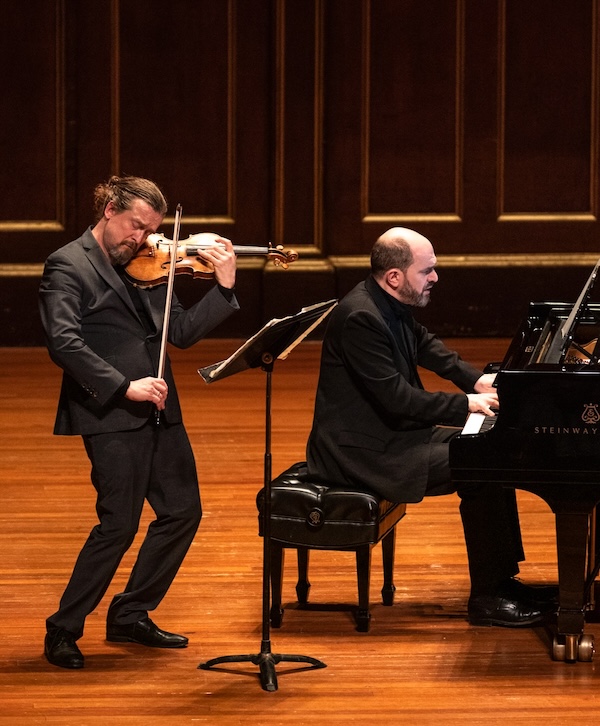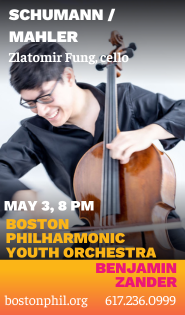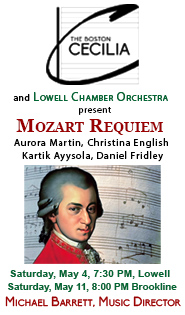Tetzlaff & Gerstein explore the radical side of Brahms and others for Celebrity Series

Violinist Christian Tetzlaff and pianist Kirill Gerstein performed Sunday at Jordan Hall for the Celebrity Series. Photo: Robert Torres
Arnold Schoenberg thought so highly of Johannes Brahms that he grafted the scion of conservative 19th-century German musical values into his artistic family tree. In a 1947 essay, Schoenberg, the arch-Modernist who founded the Second Viennese School and birthed the twelve-tone method, even went so far as to canonize his predecessor as “Brahms the Progressive.”
Though there wasn’t any Schoenberg in Christian Tetzlaff and Kirill Gerstein’s Celebrity Series recital at Jordan Hall on Sunday, the younger Austrian symphonist’s spirit certainly hovered nearby. In fact, it seemed as though the duo’s lineup of music for violin and piano by Leoš Janáček, György Kurtág, Béla Bartók, Thomas Adès, and Brahms himself was meant, in part, to justify Schoenberg’s creed.
Brahms was represented by the Violin Sonata No. 3, which dates from the closing part of his career. While quite lyrical, the score isn’t entirely warm and fuzzy, though its themes and syntax are familiar.
On Sunday, Tetzlaff and Gerstein ably mined its riches while steering clear of bathos. The outer movements were urgent and rhythmically tight, the Adagio, fervent and gorgeous. Their take on the scherzo snapped.
But what also came to the fore in this reading were the sonata’s stark plays of contrast: austerity and sumptuousness, grit and tenderness, comfort and unpredictability. At least in these artists’ hands, those particular elements seemed as central to Brahms’s expressive DNA as his melodic designs and harmonic progressions.
Interestingly, those selfsame qualities were shared, sometimes potently and unexpectedly, between every one of Tetzlaff and Gerstein’s other selections.
Janáček’s Violin Sonata, for instance, is nothing if not a play of diverging musical arguments. Written as Europe descended into the abyss in the summer of 1914, the work’s four movements are tightly organized around a series of motivic cells. As the sonata proceeds, its tone becomes more violent and erratic: in the finale, the violin’s attempt at a lush, flowing melody breaks down into a series of spitting tattoos.
Sunday’s performance captured this tragic aspect of the music with haunting intensity, Tetzlaff’s violin at times sounding like a muted machine gun. His execution of the Allegretto’s braying glissando figures were likewise vigorous.
Where’s the line, Janáček seems to be asking, between music and noise? Order and chaos? Life and death? Who knows – though, by the double bar, the first movement’s tempestuous folksiness and the ethereal turns of the Ballada felt like they came from a very different time and place.
Bartók’s Violin Sonata No. 2 sounds like it hails from a different time and place, too, though for other reasons. Written just eight years after the Janáček, it traffics in the Hungarian master’s grittiest style, one that owed more than a few debts, in fact, to Schoenberg’s influence.
And yet the Second Sonata is also a score that’s steeped in the rhythms and gestures of Eastern European folk music and hardly devoid of sweeping melodic figurations. Sunday’s performance captured this side of Bartók’s writing well, particularly via Tetzlaff’s wild second-movement fiddling and Gerstein’s incisive, beautifully directed pianism.
The pair reveled, too, in the Sonata’s play of invention, exploring its digressions of sonority, texture, and mood with aplomb. They managed this through a breathtaking display of interpretive virtuosity, their reading seeming to know exactly how each of the score’s moving parts should speak and in what accent. The results were supremely invigorating and superbly characterful.
Kurtág’s Tre pezzi and Adès Suite from The Tempest proved less momentous but similarly pleasing. The former, a densely packed set of miniatures, offered playfulness in the central Vivo’s contrasts of temperament and hushed mystery in its aphoristic outer thirds.
Adès’ distillation of themes from his 2003 opera furnished a little bit of everything: coyly seductive turns of phrase in “Caliban,” exceptional keyboard voicings in “Ariel,” and dreamy, soaring ensemble in the finale. The purely unfolding melodic lines in the third movement (“Miranda”) inhabited a world all their own.
For an encore, Tetzlaff and Gerstein reached further back into the canon with the Adagio from Beethoven’s Violin Sonata No. 6. Their performance possessed all the shapeliness, all the drama, all the fresh variety and inquisitiveness present in each number they’d already assayed. Among other things, this was a timely reminder that Brahms, as Schoenberg was well aware, wasn’t the past’s only noteworthy progressive.
The Celebrity Series presents Yo-Yo Ma and Kathryn Stott playing works by Shostakovich, Pärt, Franck, and others 8 p.m. Tuesday at Symphony Hall. celebrityseries.org
Posted in Performances

